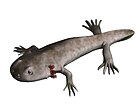파리옥시스
Parioxys| 파리옥시스 시간 범위: 얼리 퍼미언 | |
|---|---|
| 과학적 분류 | |
| 킹덤: | 동물계 |
| 망울: | 척색 동물문. |
| 등급: | 양서류 |
| 주문: | †템노스폰딜리 |
| 패밀리: | †Parioxyidae 무스타파, 1955년 |
| 지누스: | †파리옥시스 콥로1878년 |
| 종 | |
파리오시스는 텍사스의 얼리 퍼미언에서 멸종된 템노스폰딜 양서류 속이다.
학문의 역사
이 종류인 Parioxys Ferricolus는 1878년 미국 고생물학자 Edward Drinking Cope에 의해 초기 Permian Texas 적침대로부터 수집된 두 개의 두개골을 바탕으로 명명되었다.[1] 이집트 고생물학자 유세프 S. 무스타파는 텍사스의 다른 지역들에서 나온 P. 페리콜루스라는 새로운 물질을 묘사했다.[2][3] 무스타파는 또 다른 종인 P.로메리(P. romeri)를 고립된 유머러스(humerus)에 근거하여 묘사했지만, 이것은 불분명하다고 여겨졌다. 두 번째 종인 P. 볼리는 1964년 캐나다의 고생물학자 로버트 캐롤에 의해 설명되었다.[4] 이 세자는 후천적인 물질로만 알려져 있다.
관계들
파리오시스는 역사적으로 에리오포이드, 더 구체적으로 P.페리콜루스 유형 물질과 같은 지역성에서 채취한 잘 알려진 에리콥스 메갈로페두스와 밀접한 관련이 있는 것으로 간주되었다. Cope 자신은 P. Ferricolus를 Eriyops의 한 종으로 열거했는데,[5][6] 아마도 Eriyops의 청소년 표본으로 여겼기 때문일 것이다.[7] Cope가 묘사한 원본 표본이 다른 저자들에 의해 무심코 다른 세자로 묘사되었을 수도 있다는 제안과 함께 그것은 곧 별개의 속으로서[8] 되살아났지만,[9] 그 친절성은 계속 논의되어 그 대신 트레마토피대에 속할지도 모른다는 일부 제안이 있었다.[10][11] 무스타파(1955a)는 파리오시스를 자신의 가족에 배치하고, 디소로포피과와 관련이 있다고 제안했다.[3] Schoch & Milner(2014년)는 대부분의 재료의 품질이 좋지 않아 계통생성학적 분석에서 시험하지 않았지만, 사료의 추가 조성에 대한 개인적인 관찰에 근거하여 Parioxys를 Dissorophae에 배치했다.[12]
참조
- ^ Cope, E. D. (1878). "Descriptions of Extinct Batrachia and Reptilia from the Permian Formation of Texas". Proceedings of the American Philosophical Society. 17 (101): 505–530. ISSN 0003-049X. JSTOR 982652.
- ^ Moustafa, Y.S. (1955). "The affinities of Parioxys ferricolus and the phylogeny of the 'eryopsoid'amphibians". Bulletin de l'Institut d'Égypte. 36: 77–104.
- ^ a b Moustafa, Y.S. (1955). "The skeletal structure of Parioxys ferricolus, Cope". Bulletin de l'Institut d'Égypte. 1: 41–76.
- ^ Carroll, Robert L. (1964). "The relationships of the rhachitomous amphibian Parioxys". American Museum Novitates (2167): 1–11.
- ^ Cope, E. D. (1882). "Synopsis of the Vertebrata of the Puerco Eocene epoch". Proceedings of the American Philosophical Society. 20 (112): 461–471. ISSN 0003-049X. JSTOR 982693.
- ^ Cope, E. D. (1888). "Systematic Catalogue of the Species of Vertebrata Found in the Beds of the Permian Epoch in North America with Notes and Descriptions". Transactions of the American Philosophical Society. 16 (2): 285–297. doi:10.2307/1005392. ISSN 0065-9746. JSTOR 1005392.
- ^ CASE, E. C. (2016). REVISION OF THE AMPHIBIA AND PISCES OF THE PERMIAN OF NORTH AMERICA : with a description of permian. insects by e. h. sellards, and a discussion of the. FORGOTTEN Books. ISBN 978-1-333-11391-9. OCLC 982773533.
- ^ Mehl, M. G. (1912-09-27). "A Revision of the Amphibia and Pisces of the Permian of North America". Science. 36 (926): 408–409. doi:10.1126/science.36.926.408. ISSN 0036-8075.
- ^ Watson, D. M. S. (1920-01-01). "The Structure, Evolution and Origin of the Amphibia. The "Orders' Rachitomi and Stereospondyli". Philosophical Transactions of the Royal Society B: Biological Sciences. 209 (360–371): 1–73. Bibcode:1920RSPTB.209....1W. doi:10.1098/rstb.1920.0001. ISSN 0962-8436.
- ^ Romer, Alfred S. (1936). "Studies on American Permo-Carboniferous tetrapods". Problems of Paleontology, USSR. 1: 85–93.
- ^ Romer, Alfred Sherwood (1947). Review of the labyrinthodontia. OCLC 253748351.
- ^ Schoch, Rainer R.; Milner, Andrew R. (2014). Sues, Hans-Dieter (ed.). Temnospondyli I - Handbook of Paleoherpetology Part 3A2. Stuttgart: Verlag Dr. Friedrich Pfeil. ISBN 9783899371703.

















